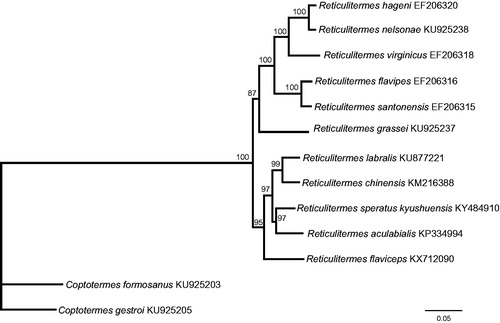Abstract
We have determined the mitochondrial genome of Reticulitermes speratus kyushuensis Morimoto, 1968. The total length of the R. speratus kyushuensis is 15,898 bp with 65.3% A + T content. It consists of 13 PCGs, 22 tRNA, and 2 rRNA genes and an A + T–rich control region. All the protein-coding genes used ATN as start codon. But the stop codons were TAA, TAG, and an incomplete termination codon (T) abutting an adjacent tRNA gene. The A + T–rich control region was 1105 bp in length with 67.8% A + T content.
Reticulitermes speratus kyushuensis Morimoto, 1968 is an economically important termite species in Korea and has damaged to traditional wooden houses or cultural properties. Although there are some taxonomic studies about this species (Becker Citation1969; Lee et al. Citation2015), there is no available information for its mitochondrial genome.
The present study reported the complete mitochondrial genome sequences of R. speratus kyushuensis. Samples were collected from Busan, Korea (the specimen is stored in Gyeongsang National University, Korea accession number: GN-160905WH08). Genomic DNA was extracted from soldiers and was sequenced by Illumina HiSeq4000 (Macrogen, Inc., Korea). Raw sequences were filtered by Trimmomatic program and were aligned against the R. labralis mitochondrial genome. The mitochondrial genome of R. speratus kyushuensis is 15,898 bp in size (accession number KY484910). Its gene content and organization were identical with other Reticulitermes species, including 13 protein-coding genes (PCGs), 22 tRNA genes, 2 rRNA genes and an A + T–rich control region (Cameron & Whiting Citation2007; Chen et al. Citation2016; Wang et al. Citation2016; Zhao et al. Citation2016). The N chain coded 14 genes, including 8 tRNA genes (tRNAGln, tRNACys, tRNATyr, tRNAPhe, tRNAHis, tRNAPro, tRNALeu(CUN), and tRNAVal), 4 PCGs (ND5, ND4, ND4L, and ND1) and 2 rRNA genes (lrRNA and srRNA), and the other 23 genes were coded by the J chain.
The overall sequences in the mitochondrial genome of R. speratus kyushuensis were A + T–biased (the G + C content was 34.7%). The PCGs region and A + T–rich region accounted for 64.0% AT and 67.8% AT, respectively. Reticulitermes speratus kyushensis had the typical 22 tRNA genes throughout the entire mitochondrial genome. All of them, except that tRNASer(AGN) lacked the dihydrouridine (DHU) stem, showed the typical clover–leaf secondary structure. Thirteen open reading frames of protein-coding sequences had typical ATN initiation codon. On the other hand, 10 genes had a complete TAA termination codon, whereas 2 genes (COX2 and ND5) showed an incomplete termination codon (T) abutting an adjacent tRNA gene, ND1 had a complete TAG termination codon. This incomplete termination codon is commonly observed in metazoan animals. The lrRNA and srRNA were located between tRNALeu(CUN) and tRNAVal and between tRNAVal and control region, respectively.
Reticulitermes speratus kyushuensis also included intergenic spacers and overlapping regions in common with other termite species. The intergenic spacer sequences were spread on 19 regions ranging in size from 1 to 22 bp, and the overlapping sequences varied from 1 to 6 bp in 5 areas. The A + T–rich control region located between srRNA and tRNAIle with 1105 bp long and 67.8% A + T content.
Nucleotide sequences of 13 PCGs from 12 closely related species were analyzed to investigate phylogenetic relationships with R. speratus kyushuensis. Phylogenetic analysis was performed using maximum likelihood method with 1,000 bootstrap replications with PhyML version 3.0 (Guindon et al. Citation2010). The phylogenetic tree revealed that Reticulitermes was a sister group to Coptotermes, and R. speratus kyushuensis and Reticulitermes aculabialis form a clade (). Our study of R. speratus kyushuensis will be a useful research for understanding the classification and status in Rhinotermitidae.
Figure 1. Phylogenetic relationships of two genera Reticulitermes and Coptotermes based on the nucleotide sequence of 13 PCGs in the mitochondrial genome. The numbers beside the nodes are percentages of 1000 bootstrap values. The Coptotermes formosanus and C. gestroi were used as an outgroup. Alphanumeric terms indicate the GenBank accession numbers.

Nucleotide sequence accession number
The complete mitochondrial genome sequence of R. speratus kyushuensis has been assigned GenBank accession number KY484910.
Disclosure statement
The authors report no conflicts of interest. The authors alone are responsible for the content and writing of the paper.
Additional information
Funding
References
- Becker G. 1969. Uber holzzerstorende Insekten in Korea. Z Angew Entomol. 64:151–162.
- Cameron SL, Whiting MF. 2007. Mitochondrial genomic comparisons of the subterranean termites from the Genus Reticulitermes (Insecta: Isoptera: Rhinotermitidae). Genome. 50:188–202.
- Chen Q, Wang K, Tan YL, Xing LX. 2016. The complete mitochondrial genome of the subterranean termite, Reticulitermes chinensis Snyder (Isoptera: Rhinotermitidae). Mitochondrial DNA Part A. 27:1428–1429.
- Guindon S, Dufayard J–F, Lefort V, Anisimova M, Hordijk W, Gascuel O. 2010. New algorithms and methods to estimate maximum-likelihood phylogenies: assessing the performance of PhyML 3.0. Syst Biol. 59:307–321.
- Lee W, Choi D-S, Ji J-Y, Kim N, Han JM, Park S-H, Lee S, Seo MS, Hwang W-J, Forschler BT, et al. 2015. A new record of Reticulitermes kanmonensis Takematsu, 1999 (Isoptera: Rhinotermitidae) from Korea. J Asia Pac Entomol. 18:351–359.
- Wang P, Zhu J, Wang M, Zhang Y, Wang J, Zhu Y, Zhang P. 2016. The complete mitochondrial genome of Reticulitermes labralis and implications for Rhinotermitidae taxonomy. Mitochondrial DNA Part B Resour. 1:392–393.
- Zhao S, Dang YL, Zhang HG, Guo XH, Su XH, Xing LX. 2016. The complete mitochondrial genome of the subterranean termite Reticulitermes flaviceps (Isoptera: Rhinotermitidae). Conserv Genet Resour. 8:451–453.
